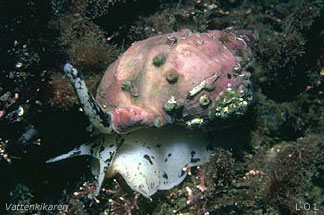
|
|
What does the whelk eat?
The whelks diet consists mainly of mussels,
polychaetes and crustaceans. The common whelk is sometimes thought to be
pest for fishermen as it attacks fish that are caught in nets by making
a hole in the fishes skin with its rasp tongue and thereafter eating the
meat with its long siphon. The whelk cannot attack fish that are not dying
or hindered from fleeing.
Whelks smell their food
The common whelk is very sensitive to smells
that are carried in water currents. With a sweeping movement of its siphon
it can even detect food upstream. Its sensitivity to smell (cemoreception)
occurs in its osphradium which is situated
in the mantle hole between the base of the siphon and the gills. Water that
flows in the mantle hole towards the gills, always passes this organ. When
the whelk picks up the scent of its prey, it moves straight towards it at
speeds of up to 13cm per minute. It also has the ability to discern between
different smells and can therefore determine if it is from a predator or
prey. When the whelk approaches its food, it lifts the anterior of its foot
and tastes the prey with both its tentacles and siphon. If the food smell
is very strong, the whelk can extract its siphon, but this rarely occurs
until it has contact with its prey.

With a sweeping movement of the siphon, the whelk uses
it sense of smell to find its food.
|

|
Page
3 of 15
|

|
|